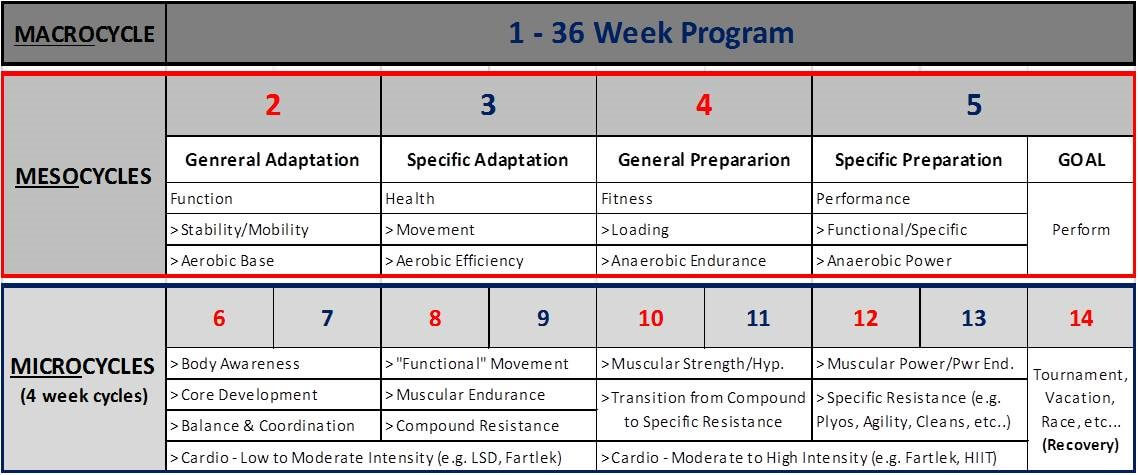Periodization Is Preparation for Fitness Success
Method of Planning is Called Periodization
One of the most common mistakes in fitness program design that some trainers and strength coaches make is not planning out a long-term strategy. These trainers and strength coaches are short-term visionaries, and the lack of long-term vision minimizes the achievement of most fitness goals! It can be argued that some clients goals are to simply active and feel good with no real specific measurement of success, which is ok and quite acceptable if that is what they are content with, but specific fitness goals must be planned and strategized in order to greatly increase the probability of achieving the desired goal.
In order to create a vision for achieving a long-term goal, one must plan a strategy that will allow for smaller goals to be achieved along the way. These smaller goals should all be used to develop a base to build on for all subsequent goals and moving towards achieving the ultimate long-term goal. In the fitness industry, this method of planning is called periodization! Below is an example of what a periodization chart may look like:
 In this general example the plan to achieve the ultimate goal has been planned out over a course of 36 weeks, and it has been split into 3 different categories: 1) Macrocycle, 2) Mesocycles, and 3) Microcycles. Each category has been given a number to help describe and visually break down each section of the plan, and this is what they represent:
In this general example the plan to achieve the ultimate goal has been planned out over a course of 36 weeks, and it has been split into 3 different categories: 1) Macrocycle, 2) Mesocycles, and 3) Microcycles. Each category has been given a number to help describe and visually break down each section of the plan, and this is what they represent:
Section 1: This is the largest sections which represents the “big picture” of the design. In periodization, this is called the Macrocycle. The macrocycle provides us with a broad picture on how the training progressions are organized, as well as the journey from the very first day of training to the very last session. The macrocycle encompasses the long-term process on how your client’s long-term goal(s) will be achieved by categorizing every training phase into smaller and more detailed fitness strategies and programs. In addition, macrocycles are generally not limited to a specific time-frame. In fact, the length of a macrocycle can run anywhere from three months, a year, or even several years depending on the client and the specified goals.
Section 2 to 5: These sections represent what are called Mesocycles. These smaller cycles break down the macrocycle into segments which separate the different stages of development and/or fitness acquisition that have been strategized to obtain the long-term fitness goal(s). For example: Section 2 may represent the first stage of development in which a client will focus on Muscular Adaptation & Body Awareness (e.g. corrective exercise), as well as developing an Aerobic Base. In contrast, the fourth stage (i.e. section 5) may be designed to be more specific to the long-term goal(s) by planning a training method and/or system that specifically mimics or closely relates to the intended outcomes.
Section 6 to 14: These smaller sections characterize the specific steps in the training progression within a shorter and more specifically detailed time span, and these are called Microcycles. Each one of these microcycles separates the different training methods and/or systems that a coach/trainer will prescribe to a client, and it is generally designed specifically to work on and master the mesocycle it falls under. The prescribed workouts within each microcycle should always focus on progressing and preparing the body for each subsequent program, thus in a way, creating continual short-term goals for each microcycle which must correlate to the main long-term goal(s).
The chart outlines the mesocycles and microcycles within a border of time which are planned in a progressive manner, but it is also important to note that exercise prescription will be dependent on a client’s rate of progression and success from the previous prescribed program. Although periodization charts clearly define all segments of fitness development within a window of time, it is common to extend and/or rearrange the time-frames if a client does not progress according to plan. This is why it is also important to schedule testing and assessments several times within your periodization to ensure that the short-term goals are being met in order to achieve the long-term goal(s)!
To conclude, taking the time to lay out a periodized plan allows one to manage and organize a training regimen that is focused and geared to achieve a long-term goal. It is often assumed that periodization is only meant for high performance athletes or clients with athletic pursuits (e.g. ½ marathons, fitness competitions, golf season, etc…), and this is a very common misunderstanding! Periodization planning can also be used to plan a strategy for clients seeking general fitness, weight loss, and even post-rehab! Developing a periodization chart is also a great tool for building confidence and trust in a program, and can provide guidance and direction to the next step ahead. So, if you want to responsibly plan a fitness regimen with a long-term goal, then you must prepare… Periodize!
Written by: Fran Quintana – MHK, BAKin, FMS-2



